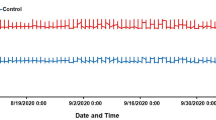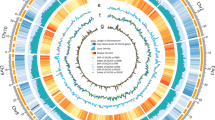Abstract
Background
The intensive application of inorganic nitrogen has contributed to increasing the crop yield with the risk of environmental damage. High nitrogen fertilizer requirements are a long-standing problem in japonica cultivation.
Materials and methods
In the present study, 200 recombinant inbred lines derived from two representative japonica varieties of Japanese and Chinese varieties, Akitakomachi and Liaogeng5, respectively, were planted under different nitrogen fertilization conditions. The relationships among nitrogen fertilization, genetic background, and important agronomic traits were surveyed through the phenotypic investigation and next-generation sequencing.
Results
The results showed that the yield components of Akitakomachi dramatically decreased along with the nitrogen reduction, whereas those of Liaogeng5 exhibited a slight decrease. The appearance quality and milling quality of both Akitakomachi and Liaogeng5 were improved, especially Liaogeng5. The recombinant inbred lines (RILs) showed similar trends to their parental lines. The QTLs analysis of important agronomic traits detected 17 loci, one QTL clustering located on chromosome 9 that corresponded to the plant height, panicle angle, grain number per panicle, harvest index, and taste value was identified to be synonymous with a previously reported gene, DEP1. The function of DEP1 was verified by a knock-out mutant constructed by CRISPR/Cas9. The dep1 mutant exhibited improved grain quality without severe yield penalty under nitrogen reduction conditions.
Conclusion
The results of the present study provide useful information for the improvement of food security by enhancing nitrogen use efficiency.





Similar content being viewed by others
Data availability
Plant material can be shared for scientific purposes.
Code availability
Not applicable.
References
Wang W, Mauleon R, Hu Z, Chebotarov D, Tai S, Wu Z, Li M, Zheng T, Fuentes RR, Zhang F (2018) Genomic variation in 3,010 diverse accessions of Asian cultivated rice. Nature 557:7703
Cheng F, Quan X, Zheng** X, Wenfu C (2020) The effect of the rice breeding process in China on the improvement of yield and quality. Rice Sci 27(5):363–367
Tilman D, Cassman KG, Matson PA, Naylor R, Polasky S (2002) Agricultural sustainability and intensive production practices. Nature 418(6898):671–677
Khush GS (2005) What it will take to feed 5.0 billion rice consumers in 2030. Plant Mol Biol 59(1):1–6
Peng S, Tang Q, Zou Y (2008) Current status and challenges of rice production in China. Plant Prod Ence 12(1):3–8
Buresh R, Witt C (2002) Challenge and opportunity in improving fertilizer-nitrogen use efficiency of irrigated rice in China. Agric Sci China 07:67–76
Peng S, Buresh RJ, Huang J, Yang J, Zou Y, Zhong X, Wang G, Zhang F (2006) Strategies for overcoming low agronomic nitrogen use efficiency in irrigated rice systems in China. Field Crops Res 96(1):37–47
Carpenter SR, Caraco NF, Correll DL, Howarth RW, Sharpley AN, Smith VH (1998) Nonpoint pollution of surface waters with phosphorus and nitrogen. Ecol Appl 8(3):559–568
Hu B, Wang W, Ou S, Tang J, Li H, Che R, Zhang Z, Chai X, Wang H, Wang Y (2015) Variation in NRT1.1B contributes to nitrate-use divergence between rice subspecies. Nat Genet 47(7):834–838
Sun J, Liu D, Wang J, Ma D, Tang L, Gao H, Xu Z, Chen W (2012) The contribution of intersubspecific hybridization to the breeding of super-high-yielding japonica rice in northeast China. Theor Appl Genet 125(6):1149–1157
Kobayashi A, Hori K, Yamamoto T, Yano M (2018) Koshihikari: a premium short-grain rice cultivar: its expansion and breeding in Japan. Rice 11(1):15
Xu H, Zhao M, Zhang Q, Xu Z, Xu Q (2016) The DENSE AND ERECT PANICLE 1 (DEP1) gene offering the potential in the breeding of high-yielding rice. Breed Sci 66(5):659
Koutroubas SD, Ntanos DA (2003) Genotypic differences for grain yield and nitrogen utilization in Indica and Japonica rice under Mediterranean conditions. Field Crops Res 83(3):251–260
Li X, Lian W, **n G, **a X, Wang X, Xu Z, Quan X (2018) Deciphering the environmental impacts on rice quality for different rice cultivated areas. Rice 11(1):7
Li X, Wu L, Wang J, Sun J, **a X, Geng X, Wang X, Xu Z, Xu Q (2018) Genome sequencing of rice subspecies and genetic analysis of recombinant lines reveals regional yield- and quality-associated loci. BMC Biol 16(1):102
Tan YF, Li JX, Yu SB, **ng YZ, Xu CG, Zhang Q (1999) The three important traits for cooking and eating quality of rice grains are controlled by a single locus in an elite rice hybrid, Shanyou 63. Theor Appl Genet 99(4):642–648
Li R, Yu C, Li Y, Lam TW, Yiu SM, Kristiansen K, Wang J (2009) SOAP2: an improved ultrafast tool for short read alignment. Bioinformatics 25(15):1966–1967
Liu D, Ma C, Hong W, Huang L, Liu M, Liu H, Zeng H, Deng D, **n H, Song J (2014) Construction and analysis of high-density linkage map using high-throughput sequencing data. PLoS ONE 9(6):e98855
Li W, Zhu Z, Chern M, Yin J, Yang C, Ran L, Cheng M, He M, Wang K, Wang J (2017) A natural allele of a transcription factor in rice confers broad-spectrum blast resistance. Cell 170(1):114–126
Hsu PD, Scott DA, Weinstein JA, Ran FA, Konermann S, Agarwala V, Li Y, Fine EJ, Wu X, Shalem O (2013) DNA targeting specificity of RNA-guided Cas9 nucleases. Nat Biotechnol 31(9):827–832
Nishimura A, Aichi I, Matsuoka M (2006) A protocol for Agrobacterium-mediated transformation in rice. Nat Protoc 1(6):2796
Ma X, Zhang Q, Zhu Q, Liu W, Chen Y, Qiu R, Wang B, Yang Z, Li H, Lin Y (2015) A robust CRISPR/Cas9 system for convenient, high-efficiency multiplex genome editing in monocot and dicot plants. Mol Plant 8(8):1274–1284
Li R, Li Y, Fang X, Yang H, Wang J, Kristiansen K, Wang J (2009) SNP detection for massively parallel whole-genome resequencing. Genome Res 19(6):1124
Huang X, Wei X, Sang T, Zhao Q, Feng Q, Zhao Y, Li C, Zhu C, Lu T, Zhang Z (2010) Genome-wide association studies of 14 agronomic traits in rice landraces. Nat Genet 42(11):961–967
Huang X, Qian Q, Liu Z, Sun H, He S, Luo D, **a G, Chu C, Li J, Fu X (2009) Natural variation at the DEP1 locus enhances grain yield in rice. Nat Genet 41(4):494–497
Wang J, Nakazaki T, Chen S, Chen W, Saito H, Tsukiyama T, Okumoto Y, Xu Z, Tanisaka T (2009) Identification and characterization of the erect-pose panicle gene EP conferring high grain yield in rice (Oryza sativa L.). Theor Appl Genet 119(1):85–91
Zhao M, Sun J, **ao Z, Cheng F, Xu H, Tang L, Chen W, Xu Z, Xu Q (2016) Variations in DENSE AND ERECT PANICLE 1 (DEP1) contribute to the diversity of the panicle trait in high-yielding japonica rice varieties in northern China. Breed Sci 66:16058
Sasaki A, Ashikari M, Ueguchi-Tanaka M, Itoh H, Nishimura A, Swapan D, Ishiyama K, Saito T, Kobayashi M, Khush GS et al (2002) Green revolution: a mutant gibberellin-synthesis gene in rice. Nature 416(6882):701–702
Li S, Tian Y, Wu K, Ye Y, Yu J, Zhang J, Liu Q, Hu M, Li H, Tong Y et al (2018) Modulating plant growth-metabolism coordination for sustainable agriculture. Nature 560(7720):595–600
Liu Y, Wang H, Jiang Z, Wang W, Xu R, Wang Q, Zhang Z, Li A, Liang Y, Ou S et al (2021) Genomic basis of geographical adaptation to soil nitrogen in rice. Nature 590(7847):600–605
Wu K, Wang S, Song W, Zhang J, Wang Y, Liu Q, Yu J, Ye Y, Li S, Chen J et al (2020) Enhanced sustainable green revolution yield via nitrogen-responsive chromatin modulation in rice. Science 367:6478
Sun H, Qian Q, Wu K, Luo J, Wang S, Zhang C, Ma Y, Liu Q, Huang X, Yuan Q (2014) Heterotrimeric G proteins regulate nitrogen-use efficiency in rice. Nat Genet 46(6):652–656
Funding
This study was funded by The National Natural Science Foundation of China, Grant Number U1708231.
Author information
Authors and Affiliations
Contributions
QX, ZX, and HX designed this study and contributed to the original concept of the project. GH and SD performed most of the experiments. QX, GH, and HX wrote the paper. All authors read and approved the final manuscript.
Corresponding authors
Ethics declarations
Conflict of interest
The authors declare no conflict of interest.
Ethical approval
This article does not contain any studies with animals performed by any of the authors.
Consent to participate
Not applicable.
Consent for publication
All authors agreed to submit the manuscript.
Additional information
Publisher's Note
Springer Nature remains neutral with regard to jurisdictional claims in published maps and institutional affiliations.
Supplementary Information
Below is the link to the electronic supplementary material.
Rights and permissions
About this article
Cite this article
He, G., Du, Z., Xu, Z. et al. Genome sequencing and genetic analysis of recombinant inbred lines reveals important agronomic traits related loci under different nitrogen fertilization. Mol Biol Rep 49, 4545–4553 (2022). https://doi.org/10.1007/s11033-022-07298-0
Received:
Accepted:
Published:
Issue Date:
DOI: https://doi.org/10.1007/s11033-022-07298-0




